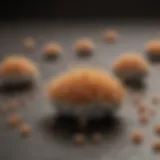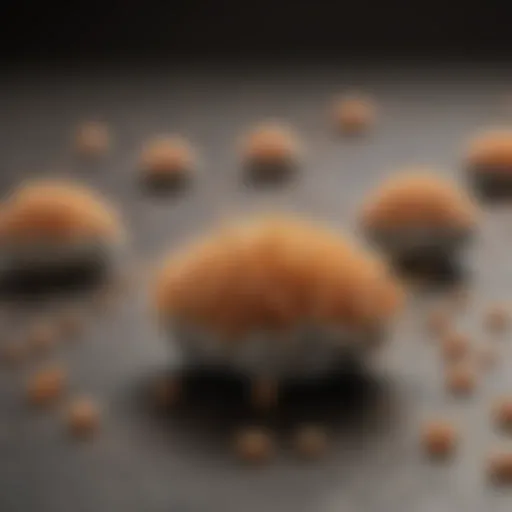Identifying Brown Recluse Infestation: Key Indicators to Watch For
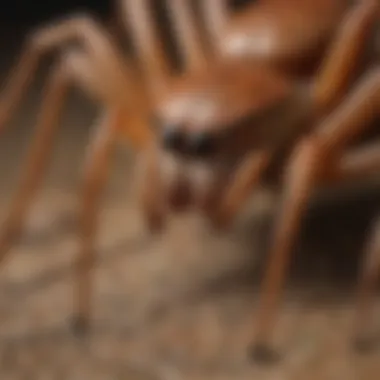

Preventive Pest Control Strategies
House Exterior Protection
When it comes to preventing brown recluse infestations, a key aspect is safeguarding your house's exterior. Sealing cracks in walls or foundations is crucial, as these tiny openings provide easy entry points for pests like spiders. Additionally, clearing away any debris around the perimeter of your home helps eliminate hiding spots for potential intruders. By taking proactive measures to prevent pests from entering your home through its exterior, you can significantly reduce the risk of infestations.
Yard Maintenance
Maintaining a well-kept yard is essential for pest control. Regularly tending to your yard by mowing the lawn, trimming bushes, and removing standing water helps create an environment that is less attractive to pests, including brown recluse spiders. Implementing methods to keep your yard pest-free, such as removing stagnant water sources that can attract insects, plays a significant role in deterring potential infestations.
Indoor Cleanliness
Creating a clean indoor environment is fundamental for pest prevention. Expert cleaning tips and techniques, such as vacuuming regularly, reducing clutter, and storing food properly, can help reduce the likelihood of brown recluse spiders seeking shelter indoors. By maintaining a pest-resistant indoor environment, you can minimize the chances of infestations taking root within your home.
Garbage Disposal
Proper garbage disposal methods are integral to effective pest control. Ensuring that your waste is efficiently disposed of not only reduces the risk of attracting pests like spiders but also prevents a potential food source for them. Emphasizing the importance of proper garbage disposal to all household members is crucial in maintaining a pest-free living space.
Other Pest Prevention Strategies
In addition to the aforementioned preventive measures, there are innovative ways to further safeguard your home against various pests, including brown recluse spiders. Exploring alternative strategies such as using natural repellents, installing pest-resistant landscaping, or investing in advanced pest control technologies can enhance your overall pest management efforts.
Introduction
In this article, we delve into a crucial topic that concerns homeowners and individuals passionate about effective pest management - the signs of brown recluse infestation. Understanding and recognizing these signs are paramount in safeguarding your living environment from potential harm and discomfort. With the prevalence of brown recluse spiders in certain regions, being equipped with the knowledge to identify their presence early can save you from extensive damage. This comprehensive guide aims to shed light on the physical characteristics, habitat preferences, behavior patterns, and other indicators that signify a brown recluse infestation. By familiarizing yourself with these signs, you can take proactive measures to address any issues swiftly and efficiently. Whether you reside in a suburban home or a countryside retreat, being aware of the telltale signs discussed in this article will empower you to protect your property and loved ones effectively.
Physical Characteristics of Brown Recluse
In the realm of pest management, understanding the physical characteristics of the brown recluse spider (Loxosceles reclusa) plays a fundamental role. Identifying these key traits not only aids in differentiation from other spiders but also serves as a crucial aspect in recognizing potential infestations. The significance of detailing the physical attributes lies in the precision it offers homeowners or pest control professionals in confirming suspected sightings within properties. By focusing on distinct elements such as the unique markings and eye arrangement of the brown recluse spider, individuals can effectively assess and address infestation risks in a timely manner, safeguarding against potential health and safety concerns.
Fiddle-Shaped Markings
One of the most notable features of the brown recluse spider is its violin-shaped marking on its cephalothorax. This distinctive characteristic sets it apart from many other spider species and serves as a primary identifier for those familiar with arachnids. The presence of this fiddle-shaped mark serves as a tell-tale sign of the brown recluse's presence, prompting immediate attention to potential infestation issues. By recognizing and understanding the significance of these markings, individuals can proactively mitigate risks associated with brown recluse encounters, enhancing overall pest management strategies.
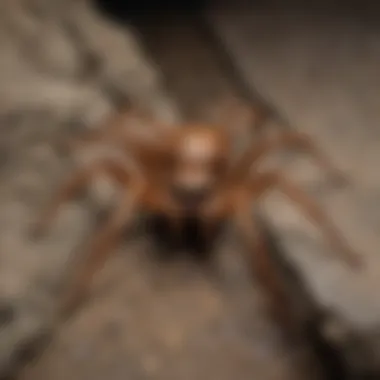

Six Eyes Arranged in Pairs
Unlike many spider species that possess eight eyes, the brown recluse spider stands out with its arrangement of six eyes grouped into pairs. This atypical eye configuration emphasizes the unique nature of these arachnids and contributes to their distinctiveness within the spider kingdom. The organization of its eyes not only aids in the spider's visual capabilities but also serves as a key identification feature for those seeking to differentiate brown recluse spiders from other common household spiders. Understanding the significance of this eye arrangement empowers individuals to accurately identify potential brown recluse sightings, facilitating prompt actions in addressing infestation concerns and ensuring effective pest control measures.
Habitat Preferences
In the realm of pest management, understanding habitat preferences is of paramount importance when it comes to dealing with brown recluse infestations. Habitat preferences refer to the specific environmental conditions that brown recluse spiders favor for nesting and survival. By delving into this aspect, individuals can proactively identify and address conducive habitats, thereby minimizing the risk of infestation within their properties. A comprehensive grasp of habitat preferences not only aids in detection but also plays a crucial role in the development of effective pest control strategies.
Dark and Undisturbed Areas
Brown recluse spiders exhibit a distinct affinity for dark and undisturbed areas within indoor spaces. These arachnids tend to gravitate towards secluded locations such as basements, attics, closets, and storage areas where light exposure is limited. Dark and undisturbed areas offer the ideal setting for brown recluse spiders to thrive due to the lack of disturbance and an abundance of potential prey. As nocturnal creatures, brown recluse spiders prefer environments that provide shelter during the day and easy access to prey at night. It is imperative for individuals to meticulously inspect such areas regularly to detect early signs of infestation and take necessary preventative measures to mitigate the risk.
Cluttered Spaces
Another key aspect of brown recluse habitat preferences is their inclination towards cluttered spaces. Clutter provides brown recluse spiders with ample hiding spots, creating favorable conditions for establishing their presence unnoticed. Piles of newspapers, boxes, clothing, and other debris serve as ideal harborage sites for these elusive spiders. The intricate web-building nature of brown recluse spiders enables them to construct webs in cluttered environments without drawing attention. Therefore, keeping living spaces organized and clutter-free is essential in deterring brown recluse spiders from colonizing within the premises. Regular decluttering and maintenance routines can significantly reduce the attractiveness of an environment to these arachnids and help prevent infestations before they escalate.
Behavior Patterns
Behavior patterns play a vital role in the comprehensive understanding and management of brown recluse infestations. By observing the behavioral traits of these elusive spiders, individuals can better assess the level of infestation and implement appropriate control measures. Recognizing behavior patterns helps in effectively identifying areas of high spider activity, thereby enabling targeted intervention strategies to mitigate potential risks within a property.
Understanding the behavior patterns of brown recluse spiders is crucial for several reasons. Firstly, nocturnal activity is a key characteristic exhibited by these spiders. Known to be more active during the night, brown recluse spiders hunt for prey and expand their territories under the cover of darkness. This behavior emphasizes the importance of thorough night-time inspections for detecting spider movement and establishing the extent of infestation.
Furthermore, retreat behavior is another significant aspect to consider when dealing with brown recluse infestations. These spiders are reclusive by nature and tend to retreat to secluded areas during daylight hours. By identifying these hiding spots and understanding their retreat patterns, property owners can strategically place traps or deterrents in areas frequented by brown recluse spiders, effectively disrupting their habitat and reducing their population.
Web Characteristics
In the realm of brown recluse infestations, understanding web characteristics is paramount for effective identification and management. The web serves as a crucial clue in pinpointing the presence of these elusive spiders within a property. By delving into the intricate details of web formation and structure, individuals can proactively mitigate the risk of encounters and potential bites.
Disorganized Webs
When examining the webs created by brown recluse spiders, one notable characteristic is their tendency to appear disorganized and haphazard. Unlike the meticulous and symmetrical webs of some other spider species, brown recluse webs lack uniformity and neatness. This disarray is a key identifier for those familiar with arachnid behavior, signaling the potential presence of these venomous spiders within the vicinity.
Brown recluse spiders opt for a pragmatic approach to web-building, focusing more on functionality rather than aesthetic appeal. Their webs may appear irregular in shape, with strands crisscrossing in seemingly random patterns. This lack of order reflects the reclusive nature of these spiders, as they prioritize efficiency and practicality in their web construction.
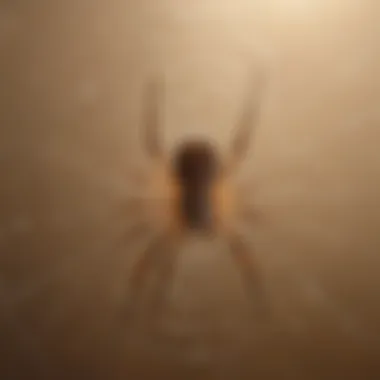

The disorganized nature of brown recluse webs also plays a role in their concealment tactics. By creating webs that blend into their surroundings and lack obvious visual cues, these spiders enhance their chances of remaining undetected by both prey and predators. This adaptive strategy underscores the evolutionary advantage of camouflage and minimalistic web design in the survival of brown recluse populations.
Low Web Traffic
Another key aspect of brown recluse web characteristics is the relatively low web traffic compared to other spider species. As sedentary predators that rely on ambush tactics to capture prey, brown recluse spiders do not exhibit the same level of web activity seen in more active hunters. This results in minimal disturbances to their webs and surrounding environment, contributing to their elusive nature.
Low web traffic is indicative of the strategic placement of brown recluse webs in areas with limited disturbance or human activity. By positioning their webs in secluded locations such as basements, storage areas, and attics, these spiders minimize the risk of disruptions that could alert homeowners to their presence. This preference for quiet, undisturbed spaces aligns with the reclusive behavior and nocturnal habits of brown recluse spiders, emphasizing their adaptability to urban environments.
Physical Signs in Property
In this article on Signs of Brown Recluse Infestation, understanding the Physical Signs in Property is crucial for effective pest management. The presence of brown recluse spiders in properties can pose serious health risks, making it essential to be able to identify the indicators of their presence. By recognizing these signs early on, homeowners can take necessary precautions to prevent infestations and protect themselves and their families.
Presence of Shed Skins
One key aspect of identifying brown recluse infestations in properties is the presence of shed skins. Brown recluse spiders molt as they grow, leaving behind their exoskeletons. The sight of shed skins in dark corners, closets, or storage areas can indicate the presence of these venomous spiders. Shed skins are often translucent and can vary in size depending on the spider's maturity.
Visible Spiderlings
Another important indicator of a brown recluse infestation is the presence of visible spiderlings. Brown recluse spiderlings resemble adults but are smaller and lighter in color. Spotting these young spiders in and around your property could signify a potential infestation. Since spiderlings can quickly mature and reproduce, it is crucial to address their presence promptly to prevent a full-blown infestation.
Health Impact
In the realm of pest management, understanding the health impact of brown recluse infestation holds paramount importance. This section delves deep into the implications that these spiders can have on human health, emphasizing the critical need for awareness and prompt action. By shedding light on the potential risks associated with brown recluse bites, individuals can take proactive measures to safeguard themselves and their families.
Necrotic Lesions
The manifestation of necrotic lesions following a brown recluse bite is a substantial cause for concern. These lesions are characterized by tissue death around the bite site, leading to the formation of a discolored, ulcerated area. The venom of the brown recluse spider contains enzymes that can cause destruction of skin cells and surrounding tissue, resulting in a severe wound that may take an extended period to heal. It is essential to recognize the early signs of necrotic lesions and seek medical attention promptly to prevent further complications.
Systemic Symptoms
In addition to localized tissue damage, systemic symptoms induced by a brown recluse bite can pose significant health risks. Systemic symptoms may include fever, chills, nausea, vomiting, joint pain, and in severe cases, hemolysis or breakdown of red blood cells. These systemic effects underscore the importance of understanding the full spectrum of possible reactions to a brown recluse bite. Early recognition and appropriate medical intervention are crucial in managing systemic symptoms and preventing the escalation of complications.
Preventive Measures
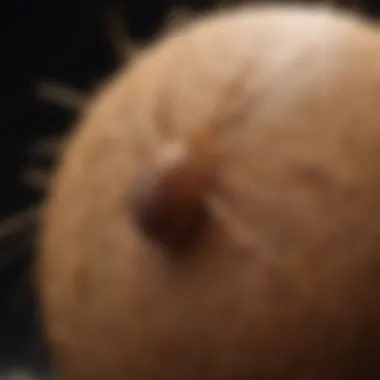

In the realm of combating brown recluse infestations, preventive measures play a pivotal role in safeguarding your living spaces. These precautions are not just about reacting to existing problems but fundamentally about proactively warding off potential threats. By integrating preventive steps into your regular home maintenance routine, you can create a hostile environment for these elusive arachnids, significantly reducing the risk of infestation.
Decluttering
Decluttering your living areas is an essential first line of defense against brown recluse spiders. These spiders thrive in undisturbed, secluded spaces cluttered with miscellaneous items. By organizing and decluttering your surroundings, you eliminate potential hiding spots for these spiders, making it harder for them to establish a presence in your home. Focus on tidying up areas such as basements, attics, closets, and storage spaces where spiders commonly seek refuge. Keep items off the floor and create a neat, orderly environment to deter brown recluse spiders from taking up residence.
Sealing Entry Points
Sealing entry points is another crucial aspect of preventing brown recluse infestations. These spiders can enter homes through tiny gaps, cracks, and openings in walls, doors, windows, and foundations. Inspect your home thoroughly for any potential entry points and seal them with caulk, weatherstripping, or other appropriate materials. Pay close attention to areas where pipes, wires, and cables enter your home, as these serve as prime entry points for pests. By blocking off these entryways, you prevent brown recluse spiders from infiltrating your living spaces, effectively fortifying your home against potential infestations.
Professional Intervention
In the realm of brown recluse infestation management, professional intervention plays a critical role in ensuring the effective eradication and prevention of these dangerous spiders. The section on professional intervention within this article serves as a vital resource for readers seeking to address infestation issues with expertise and precision. By delving into the specifics of professional intervention, readers can gain a thorough understanding of the intricacies involved in seeking help from pest control professionals.
Professional intervention offers a range of benefits that are essential for dealing with brown recluse infestations. Pest control experts possess the knowledge and tools required to assess the extent of the infestation accurately. Utilizing their expertise, these professionals can devise customized treatment plans tailored to the unique needs of each property. Through their specialized skills, they can effectively eliminate brown recluse spiders and implement preventive measures to safeguard against future infestations.
Moreover, professional intervention provides a systematic approach to addressing brown recluse infestations. Pest control services follow a structured process that begins with a comprehensive inspection of the property. During this phase, professionals conduct a thorough assessment to identify presence, sources of entry, and level of infestation. Subsequently, they proceed to implement targeted treatment strategies that involve the use of safe and effective insecticides, traps, and exclusion methods to eradicate brown recluse spiders.
When considering professional intervention, it is crucial for individuals to weigh certain considerations. While seeking pest control services is beneficial, it is essential to engage reputable and certified pest control companies with a proven track record of success in managing spider infestations. Additionally, individuals must communicate openly with pest control professionals, providing relevant information about infestation signs and any previous attempts at mitigating the issue. By fostering clear communication and collaboration with experts, individuals can enhance the efficacy of treatment and ensure long-lasting protection against brown recluse infestations.
Seeking Pest Control Services
Seeking pest control services is a pivotal step in addressing brown recluse infestations effectively. When confronting these potentially hazardous spiders, enlisting the assistance of professional pest control providers can offer individuals peace of mind and assurance in dealing with the infestation comprehensively.
Pest control services are equipped with the necessary expertise and resources to handle brown recluse infestations efficiently. Their specialized knowledge of spider behavior and biology enables them to conduct thorough inspections to identify key infestation areas within a property. By employing advanced techniques and tools, pest control professionals can accurately assess the scope of the infestation and develop targeted treatment plans to eradicate brown recluse spiders.
Furthermore, seeking pest control services ensures the safe and proper application of treatment methods. Pest control providers utilize industry-approved insecticides and eco-friendly solutions to eliminate brown recluse spiders while minimizing risks to human health and the environment. By entrusting the treatment process to trained professionals, individuals can rest assured that the infestation will be addressed in a safe and effective manner.
Prior to engaging pest control services, individuals should conduct research to select reputable companies with a proven track record of success in managing brown recluse infestations. It is advisable to request quotes from multiple providers, comparing services offered, pricing structures, and customer reviews to make an informed decision. By investing in professional pest control services, individuals can effectively combat brown recluse infestations and create a safe living environment free from the threat of these venomous spiders.
Inspection and Treatment
The inspection and treatment phase of professional intervention in brown recluse infestations is a pivotal component in the successful management of these hazardous spiders. Through meticulous inspections and targeted treatment approaches, pest control professionals can eradicate brown recluse infestations and implement preventive measures to safeguard against future occurrences.
The inspection process is a detailed and systematic assessment carried out by pest control experts to identify areas of infestation and potential entry points for brown recluse spiders. Professionals thoroughly examine indoor and outdoor spaces, including dark and secluded areas where spiders are likely to hide. By conducting comprehensive inspections, pest control providers can accurately determine the extent of the infestation and develop tailored treatment strategies to address the problem effectively.
Following the inspection, pest control professionals implement a multifaceted treatment plan designed to eliminate brown recluse spiders and prevent their return. Treatment methods may include the targeted application of insecticides in infested areas, the installation of traps to capture spiders, and the sealing of entry points to prevent reinfestation. By combining these tactics, pest control experts can eradicate existing spiders, disrupt their breeding cycles, and create an inhospitable environment for brown recluse spiders to thrive.
Throughout the inspection and treatment process, individuals are encouraged to cooperate with pest control professionals, following any guidelines or recommendations provided for preparing the property and ensuring the efficacy of treatment. By actively participating in the pest control efforts, individuals can contribute to the success of the treatment and enhance the overall effectiveness of eradicating brown recluse infestations from their homes.
